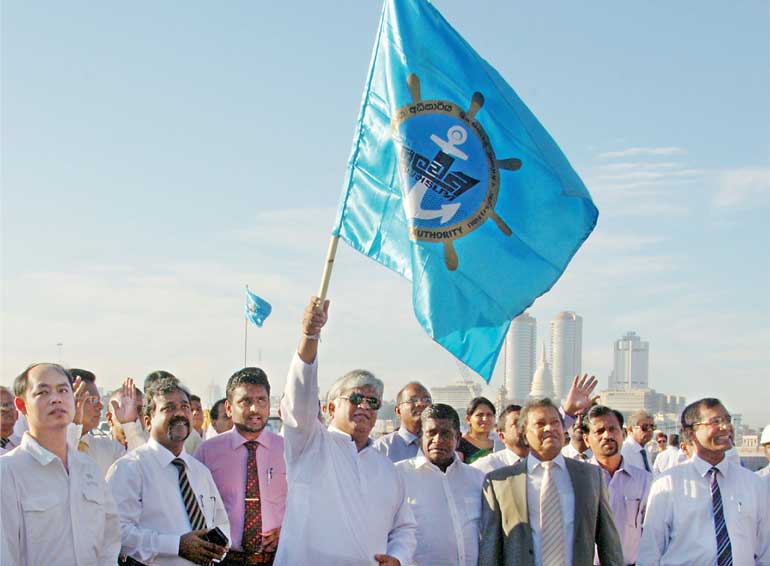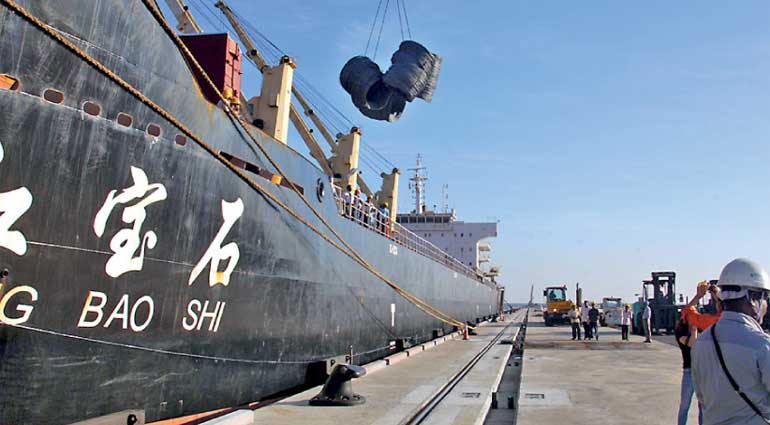Friday Apr 26, 2024
Friday Apr 26, 2024
Tuesday, 5 April 2016 00:03 - - {{hitsCtrl.values.hits}}
Billions of dollars are being spent on expanding port facilities in Sri Lanka but the absence of an overall development plan is evident. The establishment of a new port in Hambantota was proposed during the early 1990s as since it was close to the world’s busiest shipping route it could link Asia and Europe. It was claimed that an estimated 36,000 ships, including 4,500 oil tankers, used the route annually.
The feasibility study for the Hambantota Port was prepared in 2005 by a Danish consultancy company which proposed a three-stage project. Stage one of the proposed harbour would create a basin of 43Ha and 17 metres deep, with two 600-metre general purpose berths and a 310-metre-long service quay, enabling the handling of 100,000 DWT capacity ships.
 Minister of Ports and Shipping Arjuna Ranatunga signals to commence operations at East Terminal of the Port of Colombo in April last year. (Below) A conventional cargo vessel Mv.Xin Hong Baoshi at the Port of Colombo. File photos
Minister of Ports and Shipping Arjuna Ranatunga signals to commence operations at East Terminal of the Port of Colombo in April last year. (Below) A conventional cargo vessel Mv.Xin Hong Baoshi at the Port of Colombo. File photos
Hambantota Phase I
Phase I was commenced in January 2008 by the China Harbour Engineering Company and Sinohydro Corporation with 85% funding from China Exim Bank. The first phase was scheduled for completion by May 2011 but the incomplete harbour was ceremonially opened six months ahead of time in November 2010 to coincide with President Rajapaksa’s birthday.
Included under Phase I was a tank farm to provide bunkering facilities. The total project cost finally reached $ 508 million. The launch of the second phase of port development commenced on the ceremonial opening day.
Phase II
Under Phase II of the project, a 450-meter-wide, 840-meter-long harbour basin was to be deepened to minus 17 meters, with an 18-meter-deep approach channel. The project includes a quay wall 2140 meters long accommodating six berths, an oil terminal 300 meters long, two feeder berths and an artificial island of 50Ha (by dumping excavated material), a flyover bridge, roads and a 60 Ha yard adjacent to the quay wall.
The new port complex required the acquisition of 1,500Ha of land. The project envisaged a large industrial area and a shipyard facility.
Phase II was estimated to cost around $ 750 million. When Phase III is also completed, the harbour will accommodate 33 vessels, making it the largest port in South Asia.
Container terminal
When the Chinese President visited Sri Lanka in September 2014, in addition to the Port City, an agreement was entered into between China Merchants Holdings (International) Company and China Harbour Engineering Company Ltd. (the Project Company) with SLPA for the development of the Hambantota container terminal with an investment of $ 808 million. The agreement allows the Project Company to operate four berths from Phase II.
The Chairman’s statement
After signing the agreement, SLPA Chairman Dr. Bandu Wickrama informed the press that the agreement only covered “the operational part” while the SLPA owns the property. The Chinese joint venture will supply container handling equipment and will guarantee revenue to the Ports Authority. The SLPA was not investing money in the Project Company.
“Our capital is the infrastructure we developed. We are not spending an additional cent. Their capital is equipment and development,” he said. Construction was expected to finish by the end of 2015.
But according to an announcement made by CMHI to the Hong Kong Stock Exchange, it will hold 64.98% of shares while the SLPA will have the remaining 35.02%. The total capital investment in the SOT is $ 601 million, of which the Chinese will invest about $ 391 million.
Bunkering
A bunkering facility and tank farm was constructed under Phase 1, located 1.2 km away from the waterfront and connected to the oil terminal through a pipeline. The facility consists of 14 tanks with a total storage of 80,000 m3. Bunkering operations in Hambantota, which commenced in June 2014 and are run solely by the SLPA, had to be suspended due to a loss of $ 19.9 million resulting from “bunkering irregularities”. Whereas, bunkering operations in Colombo are carried out by five companies including the SLPA.

Industries
The availability of ample land around the Hambantota Port will attract industries and shipbuilding and the Chinese have requested 1,000 acres for an industrial complex. Meanwhile, Laugfs Terminals Ltd. signed a Business Venture Agreement to construct a liquefied petroleum gas terminal at Hambantota with an investment of over $ 80 million and awarded the construction of the terminal to a Chinese contractor. Once completed it will be South Asia’s largest LPG terminal.
Colombo South Harbour
By 2000, the Colombo Port possessed three container terminals, including seven container berths and four feeder berths handled by South Asia Gateway Terminals (SAGT) and the SLPA. But congestion in the port caused delays and the port was levied with surcharges. To meet the demands of increasing cargo traffic, the SLPA proposed the ‘Colombo Port Expansion Project’.
The project proposed a main breakwater 5.14 kilometres in length, a secondary breakwater of 1.65 kilometres, an access channel 570 metres wide, 20 metres deep and nine kilometres long along with the basic infrastructure. The harbour comprises an area of 600 Ha, 18 meters deep with three terminals 1,200 meters each accommodating three adjacent berths.
Port improvement work was expected to cost $ 400 million and the ADB agreed to fund $ 300 million.
International tenders were called in 2006 for the construction of breakwaters and quay walls, and for the privilege of operating the South Terminal. Allegations of corruption delayed the tendering process. Finally the ADB agreed to fund the Harbour Infrastructure work (breakwaters, etc.) costing $ 375.1 million. The construction of breakwaters and quay walls commenced in April 2008 and was completed in September 2012.
South Terminal
The successful bidder for the construction and operation of the South Terminal was China Merchant Holdings for the privilege of the 35-year BOT deal. CICT commenced construction work in December 2011 and the terminal commenced operations on August 2013, almost 15 months ahead of schedule. The South Harbour, located midway on the East-West sea lane, became the first deep-sea port in Sri Lanka capable of handling mega container ships.
Output
Container handling at the Colombo Port is carried out by the SLPA, SAGT and CICT. With the opening of the South Terminal by the end of 2014 containers handled by the Colombo Port increased by 14% to 4.9 million TEUs.
The performance compares with an annual growth rate of 1% during the previous four years. The SLPA and SAGT berths with a lower depth could accommodate only smaller vessels and their share went down by 15.5%, while the CICT showed an increase of 13%.
Efficiency: Chinese vs. locals
According to the Chinese, “The government terminals employ 8,000 people and handle two million TEUs. We are approaching 1.3 million TEUs with 1,000 workers. Ours is not an employment generating agency and we intend to keep it that way.” The Chinese also speak of the endless tea breaks of local machine operators.
Improving East terminal
The East Container Terminal (ECT) has a 1200-meter-long quay wall, allowing three berths and a water depth of 18 meters. The developer SLPA completed the 400-meter first phase, a single berth with a yard, with an investment of $ 80 million. The terminal was opened by the Minister of Ports and Shipping Arjuna Ranatunga in April 2015, when a Chinese vessel unloaded some cargo with the ship’s equipment.
But container handling requires the installation of necessary equipment. In June 2015, Cabinet gave approval to call tenders for four handling cranes and 12 gantry cranes.
Water filling of Hambantota
The contractor for Stage 2 of the Hambantota Harbour has completed construction of the quay walls and excavation of thee basin; the filling of the port-basin began on 12 July 2015 with a simple ceremony attended by the Ports and Shipping Minister. The filling of the basin with sea-water was expected to take 50 days, thereafter the coffer-dam separating Phases I and II would be removed, linking the new basin to the sea.
Colombo vs. Hambantota
The completion of Phase 2 of the Hambantota Port would avail six berths for development. The first phase, which was already completed but not used for handling containers, consists of two 600-meter general purpose berths, a 310-meter bunkering berth and a 120-meter small craft berth at a depth of 17 meters. Thus the total availability at Hambantota would become eight deep-water berths.
The Colombo South Harbour has provisions for nine deep-water berths at the South, East and West terminals. Three berths are operated by CCC, one completed by the SLPA needing equipment and five more berths await development. The 13.5 meter-deep old harbour has seven container berths and four feeder berths, which would serve smaller carriers.
According to Ports Minister Ranatunga in January 2016, “The second phase of the Hambantota port is scheduled to be completed by April.”
Did he mean the container terminal offered to China Merchants Holdings (International) Company and China Harbour Engineering Company Ltd in September 2014 and expected for completion in December 2015 would commence operations? The Chinese completed the South terminal in 15 months. The potential opening of a terminal at Hambantota seems to be a subject which no one wants to comment on.
Future of shipping for Sri Lanka
Last year, Sri Lanka was able to improve container handling while the output of most harbours, including those in Singapore dropped. In 2015, Singapore added 15 more berths to their existing 52 berths and the next two phases of improvement will be operational by 2017. In addition, Singapore wishes to add automation to improve productivity. India too is improving their harbours. Thus to keep its share of business, Sri Lanka will have to fight hard.
Non-operation of Hambantota
The development of the Hambantota and Colombo South harbours in parallel at a massive cost highlighted the absence of clear policy on port development. The non-operation of container handling at Hambantota Harbour Stage I was due to a contract agreement for the South Terminal of the Colombo South Harbour signed by China Merchant Holdings with SLPA including a clause holding up cargo-handling at Hambantota until the South Terminal reached two-thirds of its capacity.
Although the Rajapaksa Government was blamed for the non-operation of the Hambantota port, the current Government too has failed to comment on the reasons for this nor has it presented a program for improvement. The senior staff of SLPA, who are well established in Colombo with fixed housing and children attending schools in the region, would not wish to be transferred to the arid Hambantota.
The biggest obstacle is the resistance from the SLPA staff from Colombo, which prevents Hambantota from handling containers, and the Minister and his brother, the SLPA Chairman, failed to realise this.
Government policy on Chinese investments
Over the past decade the country invested billions of dollars of borrowed funds. The loans need repayment with interest but the projects are unused or underutilised. The Prime Minister has shown a willingness to recommence the Port City, get Chinese assistance to commence operations at Hambantota and Mattala airport to break-even to service these loans.
The suspension of the Port City was due to the incomplete environment report which was the responsibility of the Government. The suspension is still active and the fates of a number of projects offered to Chinese contractors are still not clear. Hopefully, these issues will be settled during the PM’s visit to China in April.
The Government’s suspension of a project commenced by the Chinese President amounts to snubbing him and this will not be easily forgotten by the Chinese. In contrast, the British response to the Chinese is an example to be followed.
Chinese President’s visit to the UK
When Chinese President Xi Jinping, visited the UK in October 2015, he arrived at Buckingham Palace in the Queen’s horse-drawn carriage, was met with a royal gun salute, receiving a warm welcome from members of the royal family.
He stayed for three nights in Buckingham Palace and held individual meetings with all major members of the royal family. At the state banquet at Buckingham Palace, the Chinese President sat between Queen Elizabeth II and Kate Middleton, the Duchess of Cambridge.
After all cordialities, the two countries signed a $ 9 billion investment agreement for a nuclear reactor by a Chinese Company, the first major nuclear project for China in a developed country. In addition, the media revealed that 150 projects were approved, for a total value of $ 60 billion and healthcare trade deals and collaborations, with the UK to train Chinese doctors and nurses, build hospitals in China and universities from the two countries to cooperate on developing cancer treatments.
The Government’s attempts to please the West by suspending and delaying Chinese-funded projects failed to achieve the expected results. The West, with its own problems, was unable to help financially. The removal of the EU ban on fish exports and the reinstatement of GSP+ concessions remain promises, forcing the Government to seek Chinese assistance. The Chinese, who are shrewd businessmen, will concentrate on their ambitions of silk road expansion and recommence delayed projects, but Sri Lanka will have to pay the price.
Investor for the East Terminal
The Cabinet accepted the SLPA proposal to offer 49% equity stake in the East Terminal to a global operator. The Cabinet also agreed to appoint ADB as the project’s Transaction Adviser and to invite expressions of interest and business proposals from interested parties for the Colombo Port’s East Container terminal.
The East Terminal will allow the SLPA to handle large container ships which are currently handled by CICT. The Ports Minister and PM have hinted that they prefer the Chinese operator for the new “East Terminal”. But a 49% stake in the East Terminal will not be acceptable for the Chinese to compete with their own South terminal holding an 85% stake.
Indian interest
India, increasingly concerned about the Chinese presence, wishes its companies to “become stakeholders in Colombo port’s expansion” given the importance of thee Colombo Port to India as a transhipment hub. It is claimed that John Keels Holdings has sought our High Commission to identify a suitable strategic investor from India to partner them in bidding for the East Terminal.
Impact of opening Hambantota
The Chinese developed terminal in Hambantota Stage 2 will be in operation soon. The location, just 17 km from the main East-West shipping route, would be welcomed by shippers, being equidistant from India’s eastern and western coasts and convenient to Myanmar, Thailand and Bangladesh and the port could offer stiff competition in transhipment and bunkering.
As containers to locals will continue to be unloaded in Colombo, some ships will continue to visit Colombo and Hambantota will cater to transhipment and as a Ro-Ro handler.
A large container carrier is supposed to cost $ 200,000 per day. Unloading at Hambantota would save half a day for the shipping company, allowing them to offer cheaper rates. The efficiency shown by the Chinese operator in container-handling will attract container carriers and will have an adverse effect on the Colombo Port.
Colombo East terminal another white elephant
Currently, 18-meter deep three berths in the South Terminal and the 13.5-meter-deep seven container berths of SLPA and SAGT handle all ships calling at Colombo port without delays. The operations at Hambantota would seriously reduce ship arrivals to Colombo. Under these conditions additional berths at East Terminal would be redundant. If the Port Minister wishes to have a deep-water terminal, he could purchase container-handling equipment as accepted by the Cabinet, but finalising the award of tenders, manufacture and delivery and operations would take at least two years. By then Hambantota will be well-established.
The balance two berths at the East Terminal, for which an international operator is requested (with or without the first berth), will not interest international players but will interest Indian investors. But if the Minister goes ahead with his own development, the country will be saddled with another white elephant.